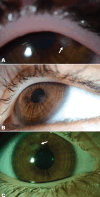Early-onset Chronic Keratitis as the First Presenting Component of Autoimmune Polyendocrine Syndrome Type 1: A Case Report and Review of the Literature
- PMID: 38084036
- PMCID: PMC12372638
- DOI: 10.4274/jcrpe.galenos.2023.2023-9-17
Early-onset Chronic Keratitis as the First Presenting Component of Autoimmune Polyendocrine Syndrome Type 1: A Case Report and Review of the Literature
Abstract
Autoimmune polyendocrine syndrome type 1 (APS-1), also referred to as autoimmune polyendocrinopathy-candidiasis-ectodermal dystrophy, is a rare monogenic autosomal recessive autoimmune disease. It is caused by mutations in the autoimmune regulator (AIRE) gene. APS-1 is diagnosed clinically by the presence of two of the three major components: chronic mucocutaneous candidiasis, hypoparathyroidism (HPT), and primary adrenocortical insufficiency. A 3.3-year-old girl presented with a carpopedal spasm to the pediatric emergency clinic. She had a history of recurrent keratitis, and chronic candidiasis, manifesting as urinary tract infections and oral thrush. HPT was diagnosed based on low serum concentrations of calcium and parathyroid hormone and elevated serum concentrations of phosphate, and treatment with calcium and calcitriol supplementation was started. Genetic testing identified a homozygous nonsense mutation, c.769C>T (p.R257X), in exon 6 of AIRE which has been reported previously. At the age of 5.6 years, she presented with adrenal crisis, and treatment with hydrocortisone and fludrocortisone was started. This case demonstrates that unexplained chronic keratitis in children may be the first and most severe component of this syndrome. The classic triad of APS-1 may also appear in the first decade of life.
Keywords: APS1; children; hypoparathyroidism; keratopathy; AIRE mutation.
©Copyright 2025 by Turkish Society for Pediatric Endocrinology and Diabetes / The Journal of Clinical Research in Pediatric Endocrinology published by Galenos Publishing House.
Conflict of interest statement
Conflict of interest: None declared.
Figures



References
-
- Finnish-German APECED Consortium. An autoimmune disease, APECED, caused by mutations in a novel gene featuring two PHD-type zinc-finger domains. Nat Genet. 1997;17:399–403. - PubMed
-
- Meloni A, Furcas M, Cetani F, Marcocci C, Falorni A, Perniola R, Pura M, Bøe Wolff AS, Husebye ES, Lilic D, Ryan KR, Gennery AR, Cant AJ, Abinun M, Spickett GP, Arkwright PD, Denning D, Costigan C, Dominguez M, McConnell V, Willcox N, Meager A. Autoantibodies against type I interferons as an additional diagnostic criterion for autoimmune polyendocrine syndrome type I. J Clin Endocrinol Metab. 2008;93:4389–4397. - PubMed
-
- Bruserud Ø, Oftedal BE, Landegren N, Erichsen MM, Bratland E, Lima K, Jørgensen AP, Myhre AG, Svartberg J, Fougner KJ, Bakke Å, Nedrebø BG, Mella B, Breivik L, Viken MK, Knappskog PM, Marthinussen MC, Løvås K, Kämpe O, Wolff AB, Husebye ES. A longitudinal follow-up of autoimmune polyendocrine syndrome type 1. J Clin Endocrinol Metab. 2016;101(8):2975–2983. doi: 10.1210/jc.2016-1821. - DOI - PMC - PubMed
Publication types
MeSH terms
Substances
Supplementary concepts
LinkOut - more resources
Full Text Sources
Miscellaneous
